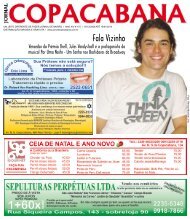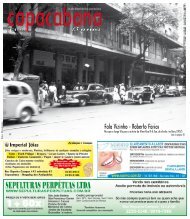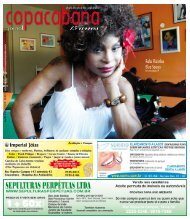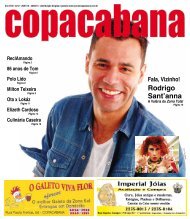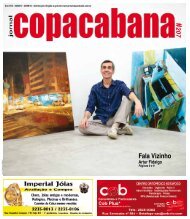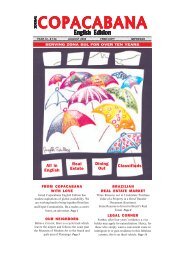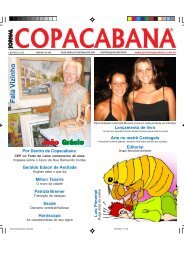Jornal Copacabana inglês 135.P65
Jornal Copacabana inglês 135.P65
Jornal Copacabana inglês 135.P65
Create successful ePaper yourself
Turn your PDF publications into a flip-book with our unique Google optimized e-Paper software.
ANUNCIE: 2549-1284<br />
Since 1993 just about everything that<br />
Chateaubriand accumulated over the years can<br />
be found in the care of Rio’s Museum of Modern<br />
Art (MAM). Chateaubriand’s initiative revived<br />
the MAM, moribund since the late 1970s<br />
after a fire destroyed its collection. A permanent<br />
exhibit offers visitors a comprehensive<br />
short course dating to modernists like Malfatti<br />
who joined leading poets and authors of the<br />
day to shock Brazilian society with their 1922<br />
Modern Art Week festival in São Paulo.<br />
Chateaubriand and MAM are also liberal<br />
lenders to other museums: modernist classics<br />
have shown at the São Paulo Industrial Federation<br />
(FIESP) and selections from<br />
Chateaubriand’s collection have appeared<br />
abroad at places like Washington’s Art Museum<br />
of the Americas.<br />
Before packing up and sending his collection<br />
to the MAM, Chateaubriand had for<br />
12 years been unable to receive visitors in<br />
his spacious apartment in the fashionable Rio<br />
de Janeiro district of Leblon because all but<br />
one room was overrun by artwork.<br />
Since MAM helped Chateaubriand clean<br />
out his apartment, guests have been treated<br />
to some excavated furnishings: a velvet chair<br />
where his father sat during Queen Elizabeth’s<br />
1952 coronation; a custom-built antique turnof-the-century<br />
English bar; nineteenth century<br />
candle holders, adapted as lamps, from a<br />
demolished French church (the priests made<br />
Chateaubriand and fellow bidders sit through<br />
mass before the auction). Chateaubriand purchased<br />
most of the furniture during his diplomatic<br />
stints in London and Paris in the 1950s<br />
and 1960s.<br />
When I visited the apartment in 1993, the<br />
walls exhibited what Chateaubriand said would<br />
become his permanent home exhibit. The dinning<br />
room was a mini-museum of Glauco<br />
Rodrigues’ irreverent paintings that satirized<br />
Brazil’s 1964-85 dictatorship. These are full of<br />
Native American figures, juxtaposed with<br />
beach bums, tourists and others from Rio’s<br />
central casting. Chateaubriand, a close friend<br />
of the artist, explained that many of Rodrigues’<br />
paintings recall Tarsila’s conscious habit of<br />
cannibalization - the consumption of European<br />
influences to produce distinctly Brazilian<br />
works. “These don’t leave here,” said<br />
Chateaubriand. “I have an affective relationship<br />
with them. They are also nostalgic reminders<br />
of my diplomatic career. The foreign ministry<br />
was full of paintings of Indians.”<br />
In fact, affection ranks high among<br />
Chateaubriand’s selection criteria when buying<br />
art. “One of the great pleasures of a collection<br />
is to put it together according to with your<br />
feelings, preferences, taste and attraction. The<br />
main law of collecting is attraction,” he said.<br />
Pancetti had his place on the wall, as did<br />
Rubens Gerchman, Manabu Mabe, and José<br />
Roberto Aguilar. But despite their rich adornment,<br />
the walls exhibited the eerie surgical<br />
stains of missing works by Brazilian masters<br />
COPACABANA<br />
COPACABANA<br />
13<br />
like Vicente Rego Monteiro and Emiliano Di<br />
Cavalcanti that had been transplanted to the<br />
MAM. Chateaubriand had also parted with<br />
Candido Portinari’s “Paisagem de Brodosqui,”<br />
a painting he loved as a boy when it was owned<br />
by his father, Assis Chateaubriand. It left the<br />
family as a gift to a Canadian businessman,<br />
who eventually took it home when he departed<br />
from Brazil. Years after Gilberto Chateaubriand<br />
gave the painting up for lost, he received a<br />
frantic call from a Rio gallery owner: “Get here<br />
quick.” When he arrived, there it was - the<br />
long lost painting.<br />
Besides “Brodosqui,” the only prominent<br />
legacy from his father’s collection is another<br />
Portinari, the 1959 “Cavalho,” a gift that the<br />
elder Chateaubriand tried to take back after<br />
one of their frequent fallings out. The painting<br />
was prominently displayed in the Rio<br />
apartment the day I visited: “It isn’t a great<br />
Portinari, but it has great symbolic value. My<br />
trophy from my battles with my father. One of<br />
the few victories I had over him.”<br />
Even some Brazilian critics mistakenly believe<br />
that Chateaubriand inherited at least the<br />
core of the collection from his father. In fact,<br />
a bitter fight over his father’s inheritance left<br />
Gilberto with a smaller financial and artistic<br />
legacy than some might expect. Gilberto has<br />
funded his collecting habit from profits garnered<br />
from his orange and sugarcane farm in<br />
São Paulo state. “What determines my buying<br />
power is the price of oranges,” he said. “I<br />
buy about three or four a month.”<br />
When I visited Chateaubriand’s relatively<br />
modest rural farmhouse in 1993, the walls of<br />
his living room were given over to works by<br />
Gervane de Paula, born in 1961. De Paula’s<br />
paintings depict regional themes (alligators<br />
are sometimes prominent) in the wetlands of<br />
his native Mato Grosso state. “It is amazing<br />
how a youngster so many kilometers from Rio<br />
de Janeiro is so well informed,”<br />
Chateaubriand remarked.<br />
Chateaubriand cultivates the friendship of<br />
emerging artists, just as he once did with<br />
Pancetti and Glauco Rodrigues and Di<br />
Cavalcanti. He will often scour the output of<br />
an artist in search of works that diverge from<br />
the norm. “Sometimes I prefer ‘marginal’<br />
works - marginal in the sense that they differ<br />
in terms of the materials or themes they usually<br />
use,” he said.<br />
A self-confessed “gallery rat,”<br />
Chateaubriand admits to once having attended<br />
four or five openings a week. But he<br />
prefers to track artists down in their ateliers.<br />
Like when he acquired that first Pancetti.<br />
Rio de Janeiro Museum of Modern Art<br />
(MAM Rio)<br />
Avenida Infante Dom Henrique, 85<br />
Parque do Flamengo<br />
20021-140 Rio de Janeiro, RJ<br />
Telephone: +(55-21) 2240-4944<br />
Fax: +(55-21) 2240-4899<br />
www.MamRio.com.br









